IDLE (Integrated Development and Learning Environment) is the default Integrated Development Environment (IDE) that comes bundled with Python. It is a simple, lightweight, and easy-to-use environment designed to help Python developers create, edit, and execute Python code. IDLE is particularly useful for beginners because of its simplicity and ease of use.
Some of the main features of IDLE are:
- Cross-platform compatibility: IDLE is available for Windows, macOS, and Linux operating systems.
- Syntax highlighting: IDLE automatically highlights keywords, comments, and other elements of Python code to improve readability.
- Code completion: IDLE provides suggestions for function and variable names as you type, making it faster and more efficient to write code.
- Integrated debugger: IDLE includes a built-in debugger that helps you identify and fix errors in your Python code.
- Interactive interpreter: IDLE has a built-in Python shell where you can execute code directly, making it easier to test and experiment with code snippets.
IDLE has two modes or “windows”: interactive mode and editor mode. The interactive mode displays an IDLE instance where you can execute code snippets in a console-like fashion. On the other hand, the editor mode allows you to use it as a simple IDE, that is, as a code editor with special features for Python.
Install IDLE Python IDE on Ubuntu
In the case of Windows and macOS, IDLE is present as soon as Python is installed. However, in the case of Linux, it is distributed as a separate application that needs to be installed.
Fortunately, IDLE is present in most of the major Linux distributions repositories, so the process is simple.
Step 1 – Update the package list
The first thing , open a terminal and update the entire operating system. This makes sure the system and package index is upto date.
sudo apt update
sudo apt upgradeStep 2- Install Idle3
As on Linux, Python is a major component of the system, it will already be installed, but to install IDLE just run the following command.
sudo apt install idle3 idle3-tools
output
Reading package lists... Done
Building dependency tree... Done
Reading state information... Done
The following additional packages will be installed:
blt idle idle-python3.10 libtk8.6 python3-tk tk8.6-blt2.5
Suggested packages:
blt-demo tk8.6 tix python3-tk-dbg
The following NEW packages will be installed:
blt idle idle-python3.10 idle3 idle3-tools libtk8.6 python3-tk tk8.6-blt2.5
0 upgraded, 8 newly installed, 0 to remove and 0 not upgraded.
Need to get 1,891 kB of archives.
After this operation, 6,739 kB of additional disk space will be used.
Do you want to continue? [Y/n] Step 3 – Run Idle
When finished, you can run it from the main menu or by executing this command
idle3Using IDLE on Ubuntu
As soon as you run it, you will see this screen
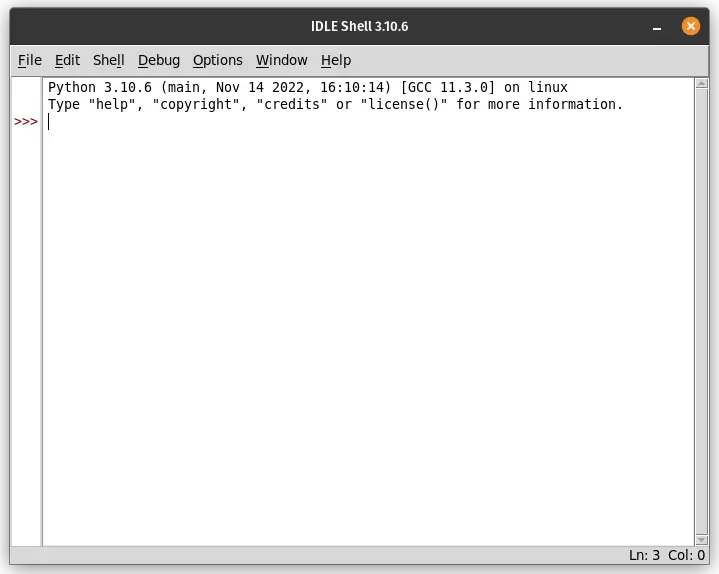
By default, you enter the interactive or console mode. Here you can run something simple like
print("Welcome to ImagineLinux")Once you press Enter, you will notice that the instruction
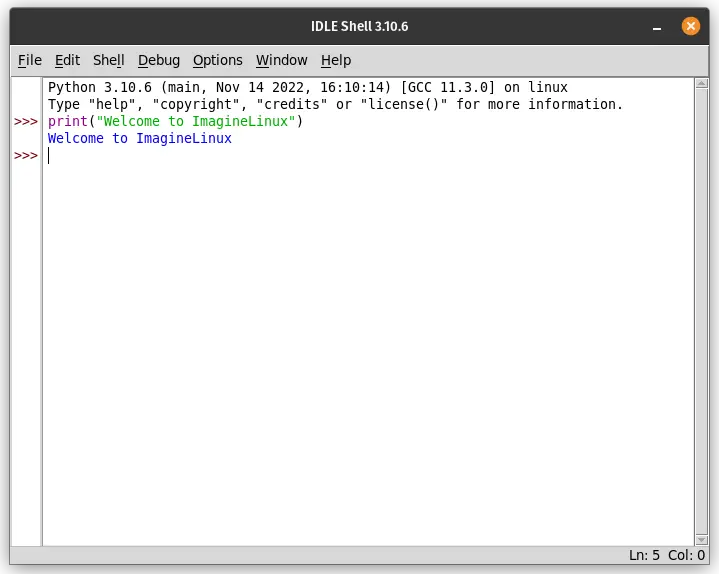
Editing Python code with IDLE
As said, IDLE is also an interesting IDE for Python. If you want to edit a python file with IDLE, you can do it from the main menu. Go to File > Open to choose the file to edit.
Another option is to create a new file. For this, you have two options: pressing the keys CTRL + N or going to the main menu File > New File.

A new blank window will pop up with the editor active. Start creating some python code.
For example,
website = "Imagine Linux"
print("My favorite website about Linux? It is " + website)Save it with a name and extension py.
To run it, just click on the menu Run > Run Module or simply press the F5 key.
Sample Output
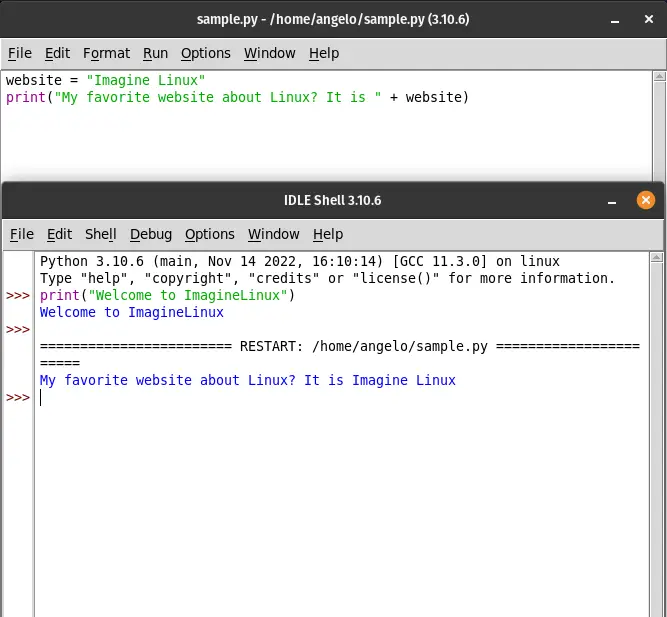
Reviewing IDLE options on Ubuntu
IDLE is very customizable, so it is worth taking a look at its options. To access them, go to Options > Configure IDLE.
There you will see many things. If you go to the Highlights tab, you can access options for how you want the editor to look.
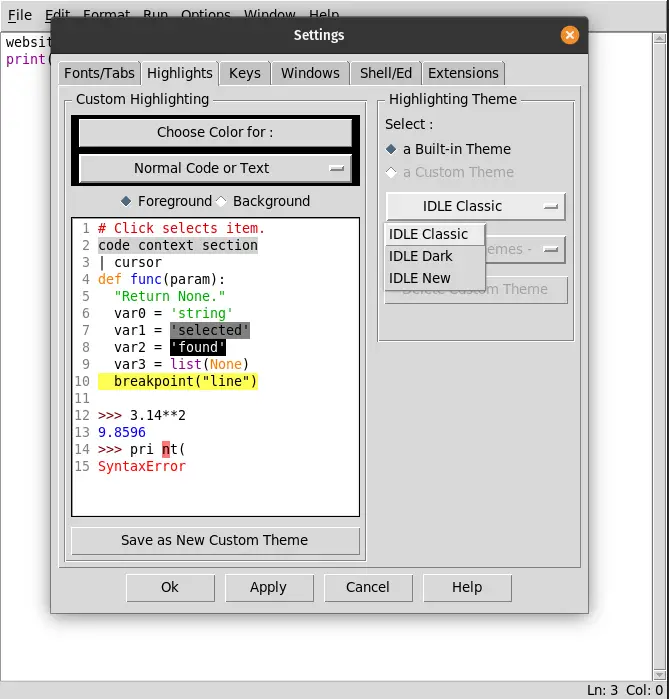
You can customize the existing theme or use one pre-built for you.
In the Windows tab, you can modify the Python indexing or choose which mode will be displayed by default.
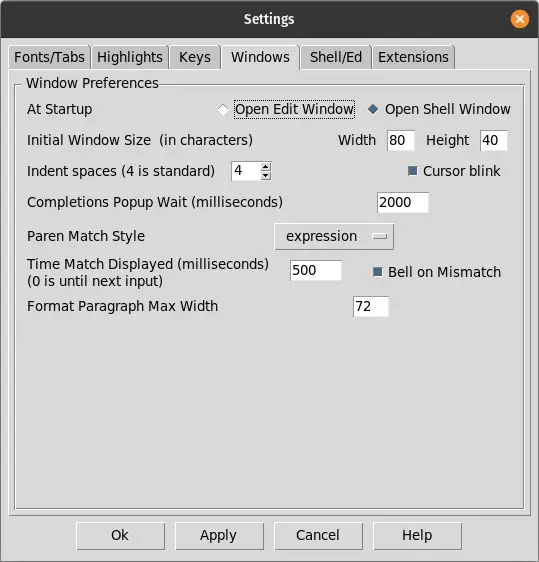
Finally, you can in the Extensions tab manage everything related to extensions. You can add a new one or disable the existing one.
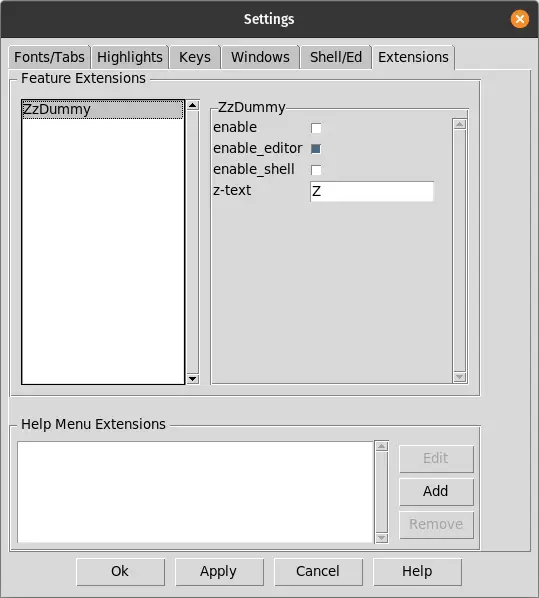
As you can notice, it is simple and intuitive.
Uninstall IDLE on Ubuntu
If you no longer want to use IDLE, you can remove it from the system. To achieve this, you can run
sudo apt remove idle3Remember that IDLE is not part of Python on Linux. So removing it will not cause any problems.
Conclusion
IDLE is a simple and lightweight Python IDE that is especially suitable for beginners and small projects. While it offers basic features like syntax highlighting, code completion, and an integrated debugger, more advanced developers might prefer alternative IDEs or code editors with more features and customization options.
Popular alternatives to IDLE include Visual Studio Code, PyCharm, Jupyter Notebooks, Atom, and Sublime Text, each offering a unique set of features catering to different programming experiences and project requirements.
Choosing the right IDE or code editor is crucial for enhancing your productivity and overall coding experience.
I hope you liked this post, and you can share it with all your friends.